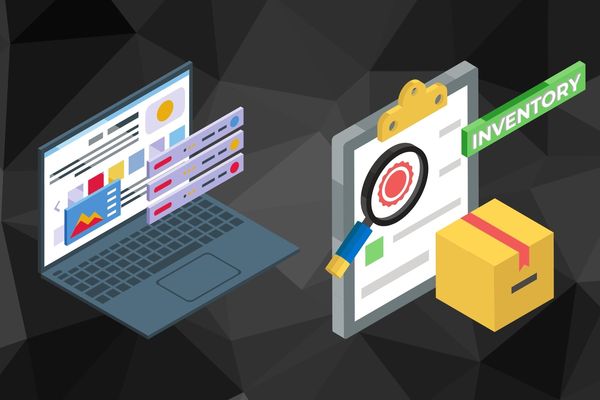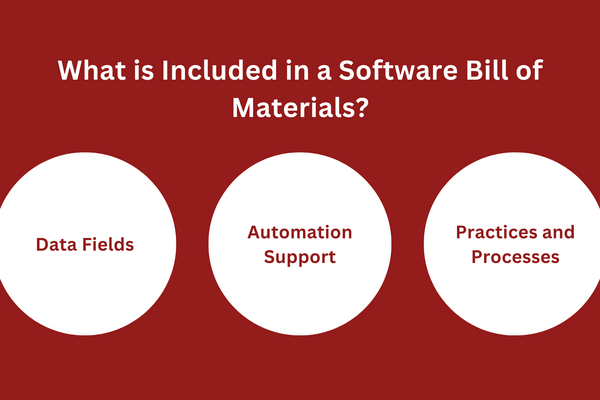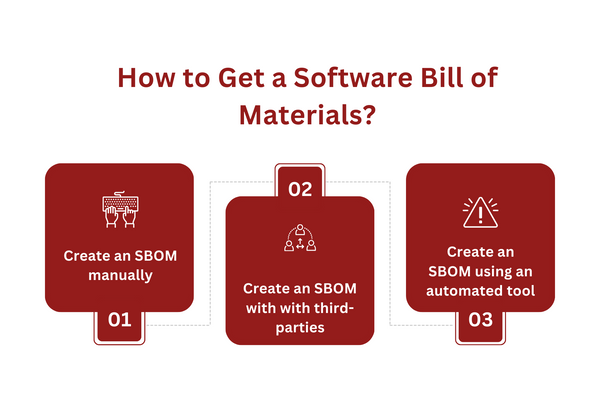
Your organization uses lots of different software and applications. If someone were to ask you about all the various components and software dependencies, we doubt you could remember or know half of them.
And yet, knowing all of these software components and their features is an important step in complying with data protection regulations.
This is why we created this software bill of materials (SBOM) guide to help you better understand what an SBOM is and why it is essential to have one.
Key Takeaways
A software bill of materials (SBOM) is an inventory of all software components and dependencies that are involved in developing a specific software.
An SBOM provides the following benefits when it comes to data protection and privacy: data security and privacy assessment, risk assessment, data breach and notification response, compliance auditing, and assessing vendor and supplier data practices.
The main challenges of an SBOM (in terms of data protection and compliance) include: the complexity of regulations, managing data privacy and confidentiality, adhering to different cross-border data transfer regulations, ensuring data subject rights are protected, and timely data breach response.
What is a Software Bill of Materials?
What is a Software Bill of Materials (SBOM).jpg

A software bill of materials (SBOM) represents an inventory of all software components and dependencies that are a part of developing a software or application.
While an SBOM is a crucial component of the software development lifecycle (SDLC), it also plays an important part in data protection regulatory compliance as it helps businesses better understand where the software their customers will use might have a potential risk.
An SBOM is not a simple list of ingredients, though. It serves to provide lineage information between different components and dependencies in a specific piece of software.
As such, a software bill of materials typically takes the form of a tree, which gives a better overview and understanding of what the software is made of (its core elements).
What is Included in a Software Bill of Materials?
What is Included in a Software Bill of Materials.png

According to a report issued by the National Telecommunications and Information Administration (NTIA) in 2021, the minimum elements of a software bill of materials are:
Data Fields
Automation Support
Practices and Processes
Data Fields
The main purpose of an SBOM is to present and help you understand the components of a software. To accomplish this, it has to have a systematic and logical structure.
A typical baseline structure of an SBOM will usually look like this:
Table
Data Field
Description
Supplier
The name of the company or organization that creates the components.
Component name
The name of the software that is given by the supplier.
Version
The supplier identifier that signifies the change in software from a previous version (v1, v2…).
Other unique identifiers
Other identifiers that are used to identify a component other than the component name and version.
License information
Licensing terms and conditions (i.e., open source or proprietary license).
Dependencies
Information on software components on which the component relies and the relationship between them.
Origin
Where the component originated from (in-house development, open-sourced, or obtained from a third party)
Security vulnerabilities
Known security vulnerabilities linked with this component.
Author of SBOM
The name of the author of the SBOM for the component.
SBOM Timestamp
Time and date of creating the SBOM (i.e., 15:30, 13/10/2023).
Automation Support
Modern software development is highly complex and is always liable to change, so manually creating an SBOM is simply not feasible or practical.
This is why, most if not all of SBOM generation needs to be fully or partially automated.
Practices and Processes
To successfully create an SBOM, define how it can be accessed, maintain it, and facilitate the collection of data it will contain, an SBOM needs certain practices and processes in place.
These are:
Frequency: A new SBOM must be created every time the software gets a new version.
Depth: At a minimum, an SBOM should include all top-level software components and their dependencies.
Known unknowns: The author of the SBOM must also identify “known unknowns” or components for which dependencies are unknown or incomplete.
Distribution and delivery: An SBOM should be available to those who might need it (regulatory agencies, auditors, vendors, end users…) in a timely fashion.
Access control: Where access control is necessary, you must outline the specific terms for it.
Accommodation of mistakes: Finally, while the information in an SBOM should be accurate, some mistakes can happen, so you must leave some room for error, particularly in the early stages of SBOM implementation.
Benefits of an SBOM
An accurate and up-to-date SBOM will help your organization identify software vulnerabilities and which components are due for an update or patch.
Overall benefits of an SBOM include:
At its core, an SBOM is nothing other than a list of all components and features of the software and applications you are using. Having a list like this can aid your business in complying with data protection regulations.
By combining 3rd-party and open-source software, an SBOM can significantly improve efficiency and promote interdepartmental collaboration by offering greater visibility into the software components, enabling better task management, reducing duplication of efforts, and streamlining the update and patching process.
An SBOM also helps software engineers detect software vulnerabilities
Finally, having an SBOM can also help your company identify weak points in the early stages of the software development cycle.
In terms of data protection compliance, the benefits of creating an SBOM are:
Data security & privacy assessment: It assists in weighing the security and privacy implications of data processing within the software.
Risk assessment: Helping businesses conduct risk assessment by identifying potentially vulnerable components and dependencies.
Data breach notification and response: An up-to-date SBOM allows the organization to identify the affected components faster and more quickly notify the stakeholders.
Compliance auditing: An SBOM further helps organizations obey data protection and privacy regulations by providing a detailed inventory of the software components.
Assessing supplier and vendors’ data protection practices: In addition to assisting your business in assessing its data security and privacy practices, an SBOM also helps you evaluate that of your suppliers and vendors.
Challenges of an SBOM
The main challenges of creating a software bill of materials include:
Lack of standardization: Different industries and even companies have different needs and standards of how an SBOM should look like and what it should include
Poor or incomplete SBOM resources: Especially as the software supply chain becomes more complex and intricate
Incomplete and/or inaccurate data: The major challenge of generating SBOMs is using tools with incomplete and inaccurate data
Lacking context: An SBOM without proper context won’t help you make sense of the data in it. It’s like trying to cook and only having a list of ingredients that go into the dish but not the steps to cook it.
In the context of data protection compliance, the main challenges of an SBOM are:
The complexity of regulatory compliance: Developing and maintaining an SBOM in compliance with data protection regulations like the GDPR, CPRA, LGPD, etc. requires a full understanding of their requirements.
Managing data privacy and confidentiality: Managing the sensitive information contained in an SBOM and preventing unauthorized access is another major challenge that enterprises have to deal with.
Adhering to cross-border data transfer regulations: For organizations that operate globally, it is essential that an SBOM also adheres to the relevant cross-border data transfer laws and regulations.
Ensuring data subject rights: The information in an SBOM must be accurate and up-to-date, which adheres to the data subject’s right to correct inaccurate or incomplete personal data. Additionally, they have the right to access their personal data in an SBOM and erase it, which you have to carefully consider and implement in your SBOM.
Data breach incident response & notification: The information in an SBOM must be accurate and up-to-date to ensure your organization can identify an affected component quickly and promptly address the security issue as well as notify the relevant stakeholders.
How to Get a Software Bill of Materials?
How to Get a Software Bill of Materials.png

There are three ways to get an SBOM:
Create an SBOM manually
Create an SBOM in collaboration with third-party vendors and software suppliers
Create an SBOM using an automated tool
For more tips on developing an SBOM, you can check this NTIA how-to SBOM generation guide.
Manually Creating a Software Bill of Materials
Creating an SBOM manually or in-house is perhaps the most involved of all three ways and it requires:
Identifying the software components you use in the software
Creating a detailed list of names, versions, licenses, and known security vulnerabilities of each software component
Verifying that the information is accurate and up-to-date
Compiling the information into a format ready for sharing
Creating an SBOM in Collab with Third-Party Vendors and Software Suppliers
If you’re developing an SBOM in collaboration with third-party vendors or software suppliers, you need to ensure that you get the necessary information from them regarding the components, have detailed documentation from them about the SBOM, and also have an open channel of communication to ensure your SBOM is always up-to-date.
Using an Automated SBOM Tool
Finally, you can use automated tools to create and maintain an SBOM.
Examples of SBOM automation tools include:
Jit
JFrog
Endor Labs
CycloneDX Maven plugin
Kubernetes bom
Closing
A software bill of materials of SBOM is an important part of the software development lifecycle (SDLC) as it helps your business identify the components and dependencies of the software or app, as well as any potential vulnerabilities.
However, as you can see, an SBOM also plays a vital role in ensuring regulatory compliance, data privacy, and security incident response and notification.
Get in touch with Captain Compliance to ensure regulatory compliance for your business and industry.
FAQs
What is in a software bill of materials?
A software bill of materials or SBOM is a detailed inventory of the components and dependencies in a specific software or application.
Take a look at our data inventory guide to help you better navigate through what it is, its importance, best practices, and more.
How do you create a software bill of materials?
Creating a software bill of materials (SBOM) can be done in three ways:
Manually
In collaboration with 3rd-party vendors and software suppliers
Using an automated SBOM generation tool
Check out our top picks for Data Subject Access Request (DSAR) automated software.
What is BOM in software development?
A BOM or bill of materials in software development is a detailed list of components that software has, including licenses, dependencies, known vulnerabilities, and more.
Here’s our guide to data discovery software.
What is an example of a BOM?
Here’s an example of a BOM for a laptop:
Display and chassis
Chassis assembly
LCD screen, 13 inches, UHD
CPU & Motherboard
Odyson logic board
2.8GHz i7 Intel Core Quad Core CPU
32GB DDR4 Random Access Memory (RAM)
Drives
1TB Hard Disk Drive (HDD)
250GB Solid State Drive (SSD)
I/O Components
Keyboard with backlight
Webcam
Touchpad
Ports & connectivity
Type-A and Type-C USB ports
HDMI port
WiFi module
Bluetooth module
Power
Lithium-ion battery
Power adapter
Outer casing
Outer casing panels
Screws
Fasteners
Accessories
User manual
Warranty documentation
Learn more about compliance on our compliance education page.